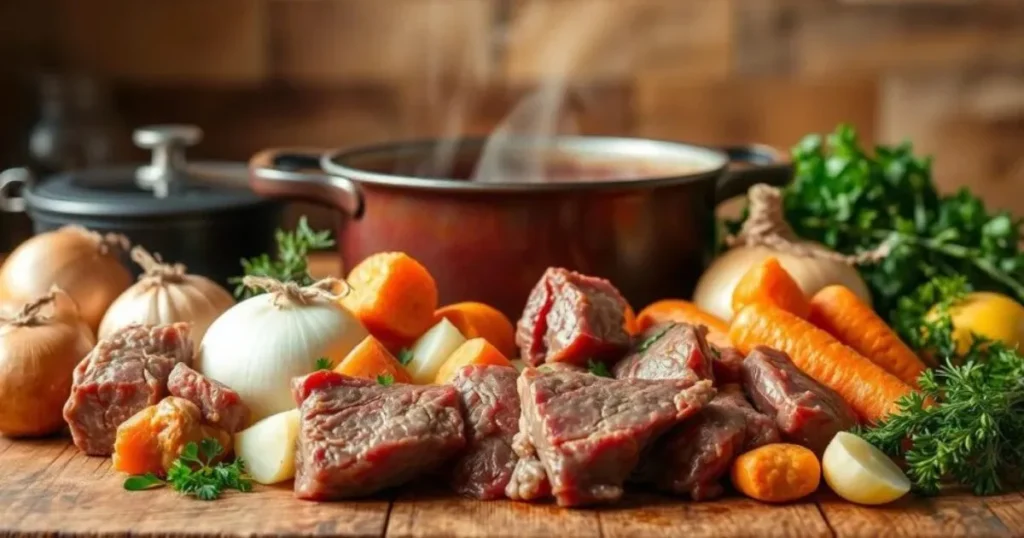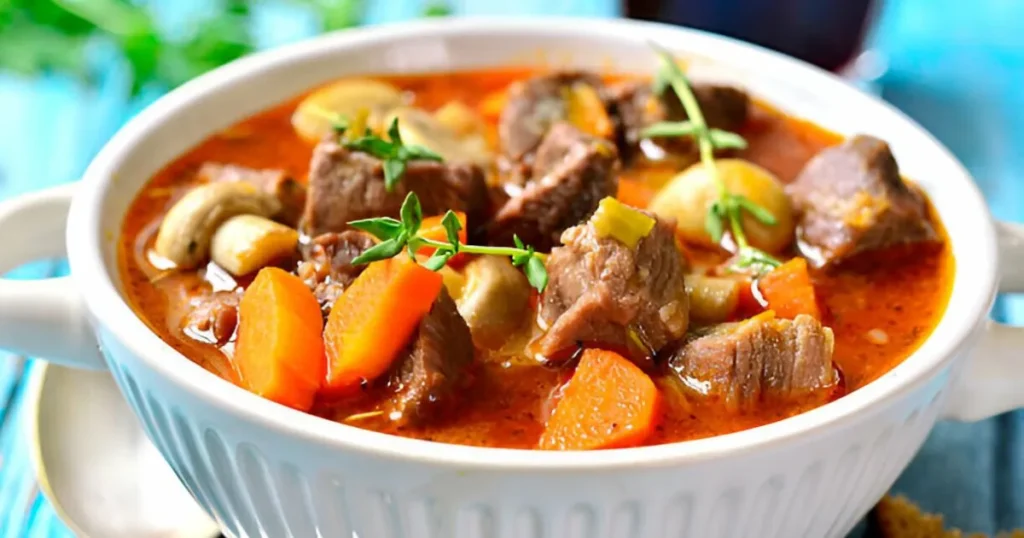Hearty Traditional Irish Beef Stew Recipe
Table of Contents
Experience the rich tastes and cosiness of a classic beef stew recipe. For years, this comfort food classic has warmed people’s hearts. This dish is an exploration of Irish culinary heritage rather than merely a meal.
Each spoonful tells a story of family traditions, rural farming life, and the joy of home cooking. When you prepare an authentic Irish beef stew, you’re not just making dinner. You’re connecting to a rich cultural experience that has sustained families for generations.
The slow-cooked tender beef, root vegetables, and deep, savory gravy turn ordinary ingredients into an extraordinary dining experience. It speaks directly to the soul.
Key Takeaways
- Traditional Irish beef stew is a beloved comfort food with deep cultural roots
- Slow cooking brings out rich, complex flavors in the dish
- The stew represents generations of Irish culinary tradition
- Simple, quality ingredients are key to an authentic recipe
- Perfect for cold days and family gatherings
The Detailed Background of the Classic Irish Beef Stew Recipe
Irish beef stew is more than a meal. It’s a journey through Ireland’s farming past. It shows survival, resourcefulness, and pride in culture.

The dish’s roots are in rural Irish communities. Families made great meals from what they had. Farmers and workers needed food that lasted all day.
Roots in Irish Farming Culture
Irish farmers created these st. patrick’s day recipes to feed families. They turned tough meat into tender, tasty dishes.
- Slow cooking tenderized less expensive meat cuts
- Used readily available root vegetables
- Provided substantial nutrition for agricultural workers
Generational Evolution
Each generation made the stew better, sharing cooking secrets. What started as a simple dish became a national treasure.
| Era | Stew Characteristics |
|---|---|
| 19th Century | Basic ingredients, minimal seasoning |
| Early 20th Century | Introduction of standardized recipes |
| Modern Day | Gourmet variations, global recognition |
Cultural Significance
Irish beef stew is more than food. It’s about community and sharing. It shows how to make something special from little. Today, it’s a key part of Irish food, especially on St. Patrick’s Day.
Essential Ingredients for Irish Beef Stew

Making a true Irish beef stew needs the right ingredients. These ingredients add depth and richness to each bite. The secret to a great Guinness beef stew is in its chosen parts, which come together for a memorable meal.
For the best Irish beef stew, you’ll need:
- High-quality beef chuck or shoulder (2-3 pounds)
- Fresh root vegetables
- Robust Guinness beer
- Aromatic herbs and spices
The first step to a top-notch Guinness beef stew is picking the best beef. Choose meat that’s well-marbled for tenderness. Chuck roast or beef shoulder is perfect for that tender, melt-in-your-mouth feel.
| Ingredient Category | Recommended Choices | Purpose |
|---|---|---|
| Meat | Beef Chuck | Provides rich flavor and tenderness |
| Liquid Base | Guinness Stout | Adds depth and complexity |
| Vegetables | Carrots, Potatoes, Onions | Enhances nutritional value and texture |
Vegetables are key in your Irish beef stew. Carrots, potatoes, and onions add flavor and nutrition. The Guinness beer is more than a drink; it’s a flavor booster that enriches the stew’s gravy.
When picking your ingredients, choose fresh and high-quality ones. Local farmers’ markets offer the best produce. They can make your beef stew recipe for guinness go from good to amazing.
Selecting the Perfect Cut of Beef for Your Stew
Creating amazing slow-cooked beef dishes begins with picking the right meat. Your comfort food classics rely on choosing beef cuts that turn into tender, flavorful dishes during slow cooking.
Not all beef cuts are the same for stews. The secret to these hearty meals is knowing which parts of the cow are best for long, slow cooking.
Best Beef Cuts for Slow Cooking
- Chuck Roast: The ultimate stew meat with excellent marbling
- Beef Brisket: Rich flavor and perfect for breaking down during cooking
- Short Ribs: Intense beef taste with incredible tenderness
- Round Cuts: Lean option that becomes super tender when slow-cooked
Quality Indicators to Look For
When picking beef for your stew, look for these quality markers:
- Consistent marbling throughout the meat
- Fresh, deep red color
- Minimal surface moisture
- Firm texture without bruising
Proper Meat Preparation Tips
Preparing your beef right ensures it’s tender and flavorful. Always trim excess fat, cut meat into uniform cubes, and pat dry before seasoning. Bringing meat to room temperature before cooking helps it cook evenly and absorb more flavor.
Pro tip: Ask your local butcher for recommendations on the best stew cuts – they’re experts in selecting premium meat!
Kitchen Tools and Equipment Needed
Preparing a delicious slow-cooked beef dish like traditional Irish beef stew requires the right kitchen equipment. The right tools make cooking smoother and more enjoyable.
For your hearty Irish beef stew, you’ll need some essential cooking tools. A heavy-bottomed cooking vessel is key. It ensures even heat distribution.
- Large Dutch Oven: Ideal for slow-cooked beef dishes, providing consistent temperature and deep flavor development
- Sharp Chef’s Knife: For precise meat and vegetable cutting
- Cutting Board: Preferably wooden, for meat preparation
- Wooden Spoon: Perfect for stirring and mixing ingredients
- Measuring Cups and Spoons: Ensuring accurate ingredient proportions
Professional chefs suggest using cast-iron or enameled cast-iron cookware. These materials keep heat well. This helps your stew simmer slowly and develop rich flavors.
Other useful tools include a meat thermometer and kitchen tongs. These help you check beef doneness and handle meat during browning. With these tools, you’ll make a memorable slow-cooked beef dish that’s true to Irish cuisine.
Step-by-Step Guide to Irish Beef Stew
Making the perfect Guinness beef stew needs focus and love for traditional cooking. This guide will show you how to turn simple ingredients into a delicious Irish dish.
Creating a tasty Guinness beef stew involves key steps for great flavor and tender meat. We’ll go through each step to help you make a true Irish dish.
Ingredient Preparation
- Cut beef into 1-inch cubes for even cooking
- Chop vegetables uniformly to ensure consistent texture
- Pat meat dry before seasoning to achieve perfect browning
Cooking Method
The secret to a great Guinness beef stew is in the cooking method. Begin by browning the meat to get deep, rich flavors.
- Heat oil in a heavy-bottomed pot
- Brown meat in batches to prevent overcrowding
- Deglaze pan with Guinness beer to capture all caramelized bits
Seasoning and Final Touches
Seasoning makes a good stew into a memorable dish. Here are tips to make your comfort food classics stand out:
| Seasoning | Purpose | Recommended Amount |
|---|---|---|
| Thyme | Adds earthy flavor | 1-2 sprigs |
| Bay Leaves | Provides depth | 2 whole leaves |
| Salt and Pepper | Enhances overall taste | To taste |
“A great stew is about patience and layering flavors” – Irish Cooking Tradition
Let your Guinness beef stew simmer on low heat for 2-3 hours. This way, all the flavors will blend together. You’ll end up with a hearty dish that truly represents Irish cuisine.
The Secret to Rich, Hearty Gravy
The secret to a delicious, hearty Irish beef stew recipe is making the ideal gravy. With the correct technique, you can create delicious slow-cooked beef dishes. In order to complement the tender meat, your gravy should be thick, glossy, and bursting with taste.
Creating an exceptional gravy involves a few important steps:
- Use cold flour for smooth thickening
- Develop a rich base with caramelized meat drippings
- Layer flavors with fresh herbs and dark stock
Thickening your stew needs careful attention. Start by making a roux – a mix of flour and fat. This gives your gravy a smooth texture. Brown the flour a bit to get rid of any raw taste and add to the gravy’s depth. You want a consistency that sticks to the back of a spoon but isn’t too thick.
“A great gravy tells the story of your entire dish” – Irish Culinary Tradition
Fresh herbs like thyme and rosemary can make your gravy stand out. Add them carefully, so their aroma boosts the beef flavors. Red wine or dark beer can also add amazing complexity to your slow-cooked beef dishes.
Remember, patience is key. Let your gravy simmer and reduce slowly. This concentrates the flavors and gives it a luxurious texture that makes your hearty Irish beef stew unforgettable.
Perfect Side Dishes and Pairings
Choosing the right sides can make your st. patrick’s day recipes stand out. Irish beef stew is a hearty base that goes well with many sides. Both traditional and modern options can elevate your meal.
Traditional Irish Accompaniments
Classic Irish sides add authentic flavors and textures to your stew. Here are some timeless choices:
- Soda bread: A dense, crusty bread perfect for soaking up stew gravy
- Colcannon: Creamy mashed potatoes mixed with kale or cabbage
- Boiled potatoes: Simple, buttery side that complements the stew’s richness
Modern Pairing Suggestions
For a modern twist, try these innovative pairings:
| Dish | Flavor Profile | Recommended Pairing |
|---|---|---|
| Irish Beef Stew | Rich, Hearty | Roasted Root Vegetables |
| Irish Beef Stew | Robust | Herbed Quinoa Salad |
| Irish Beef Stew | Savory | Crisp Green Salad |
Your comfort food classics deserve sides that make the meal special. Whether you like traditional or modern sides, these ideas will make your Irish feast unforgettable.
Advice for Preparing the Irish Beef Stew Recipe
Preparing slow-cooked beef dishes like Irish beef stew in advance is a big help for busy cooks. These comfort foods get even better with time, letting flavors grow stronger.
For a delicious make-ahead Irish beef stew, know how it changes over time. Beef dishes get better with resting and blending flavors. So, your stew will be even tastier the next day.
- Prepare the stew 1-2 days before serving for optimal flavor
- Cool the stew completely before storing in airtight containers
- Refrigerate for up to 4 days or freeze for up to 3 months
Here are some tips for reheating your stew:
- Thaw frozen stew in the refrigerator overnight
- Reheat slowly on the stovetop, stirring occasionally
- Add a splash of beef broth if the stew seems too thick
| Storage Method | Duration | Recommended Reheating |
|---|---|---|
| Refrigerator | 3-4 days | Stovetop, low heat |
| Freezer | 2-3 months | Thaw overnight, reheat gently |
Pro tip: Always taste and adjust seasonings after reheating to ensure your comfort food classics maintain their rich, hearty flavor.
Common Mistakes to Avoid
Making the perfect hearty Irish beef stew needs skill and care. Even seasoned cooks can slip up, ruining the dish’s rich taste and tender meat.
When making a Guinness beef stew, several common mistakes can ruin your dish. Knowing these pitfalls will help you make a meal to remember.
- Meat Selection Errors
- Choosing lean cuts that become tough during cooking
- Skipping meat trimming and preparation
- Not cutting beef into uniform chunks
- Cooking Technique Mistakes
- Rushing the cooking process
- Overcrowding the pot
- Cooking at too high a temperature
- Seasoning Challenges
- Underseasoning the stew
- Adding herbs too early
- Not allowing flavors to develop
Your Guinness beef stew recipe needs patience and precision. Cooking it low and slow makes the meat tender and the flavours deep. Brown the meat well before adding liquids for a rich base.
Preparing vegetables is also key. Cut them to similar sizes for even cooking. Add softer veggies like peas or parsley late to keep their texture and color.
Pro tip: Let your stew rest for 15-20 minutes before serving to allow flavors to fully meld together.
Storing and Reheating Your Irish Beef Stew Recipe
Keeping your slow-cooked beef dishes tasty means storing and reheating them right. Your comfort food classics need special care to keep their flavor and texture.
The secret to savouring your Irish beef stew recipe over multiple meals is to store it carefully. Before putting the stew in the refrigerator or freezer, allow it to cool fully.
Refrigerator Storage Guidelines
- Store in an airtight container
- Refrigerate within 2 hours of cooking
- Keep for 3-4 days maximum
- Use clean, sealed containers
Reheating Best Practices
Reheating your stew gently is important to keep its rich flavors and tender meat. Here’s how to make sure your meal is always delicious:
- Stovetop method: Reheat on low heat, stirring occasionally
- Microwave option: Use medium power, stir every 30 seconds
- Oven method: Cover and warm at 350°F for 20-25 minutes
Your Irish Beef Stew Recipe Can Be Freeze-Stored
Freezing is a great way to keep your comfort food classics fresh longer. Follow this guide for the best results:
| Storage Method | Duration | Recommended Container |
|---|---|---|
| Freezer Storage | Up to 3 months | Freezer-safe container or bag |
| Freezing Tips | Leave 1-inch space for expansion | Label with date and contents |
Pro tip: Always thaw frozen stew in the fridge overnight for the best texture and flavor in your slow-cooked beef dishes.
🌎 Top picks from Amazon 📦🛒
STIRMAX DELUXE 7.5Qt Multi-Cooker | 9-in-1 with Auto Stir & Shred
INKBIRD WiFi Sous Vide Cooker | 1000W, App Control & 3D Circulation
Beelicious Vacuum Sealer | 85KPA, 8-in-1, Built-in Cutter & Storage
Conclusion
It takes more than just cooking to make a filling Irish beef stew recipe. It’s about establishing a connection with a rich culinary past. This exploration of the traditional recipe takes you closer to the essence of Irish food. Simple ingredients are transformed into a hearty meal that soothes the body and the spirit.
St. Patrick’s Day recipes like this stew are more than food. They capture generations of family cooking. They show how beef, vegetables, and careful preparation can make something truly special. Whether celebrating Irish culture or just wanting a hearty meal, this stew will become a favorite in your kitchen.
The dish’s beauty is in its simplicity and flexibility. You can make it your own with local ingredients or family techniques. From slow cookers to Dutch ovens, every kitchen can make a delicious version. Embrace the tradition, enjoy the process, and savor each spoonful of this timeless Irish culinary treasure.
Great cooking is about passion, patience, and practice. Your hearty Irish beef stew is a delicious link to a vibrant culinary tradition. It inspires home cooks around the world.
FAQ
What makes Irish Beef Stew different from other beef stews?
Irish Beef Stew is known for its rich flavor and use of Guinness beer. It also includes root vegetables and slow-cooked beef. These ingredients come from Ireland’s farming traditions, making the stew both comforting and flavorful.
Can I make this stew without Guinness?
Yes, you can use beef broth, red wine, or dark beer instead of Guinness. While Guinness adds a special flavor, the stew will still taste great. Adding a bit of worcestershire sauce or dark soy sauce can help keep the flavor rich.
For the Irish Beef Stew Recipe, what kind of beef is best?
Chuck roast, beef shoulder, or short ribs are the best cuts. They are tender and flavorful when slow-cooked. This makes the stew perfect for enjoying.
The Irish Beef Stew Recipe: How long should I simmer it for?
Cook it for 2-3 hours on low heat for tender meat. Slow cooking enhances the flavors. If using a slow cooker, cook on low for 6-8 hours.
Can I make this stew in advance?
Yes, it tastes better the next day. Prepare it 1-2 days ahead and refrigerate. Reheat slowly, adding broth if it’s too thick.
Is Irish Beef Stew gluten-free?
Traditional recipes have gluten from flour. But, you can make it gluten-free by using cornstarch or gluten-free flour. Always check your ingredients for gluten.
What are the best side dishes to serve with Irish Beef Stew?
Serve it with Irish soda bread, colcannon, or roasted root vegetables. Simple buttered crusty bread is also great. These sides enhance the stew’s flavors.
How long can I store Irish Beef Stew in the refrigerator?
Store it in an airtight container for 3-4 days. Cool it completely before refrigerating. Reheat well before serving. Freeze for up to 3 months for longer storage.


